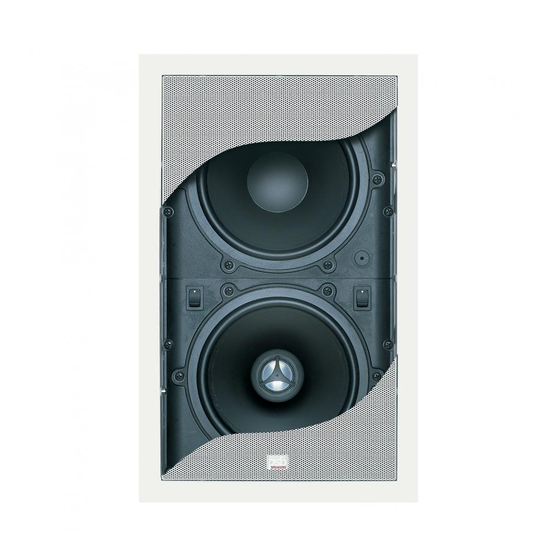
Advertisement
Quick Links
A New Standard of Sonic Performance, Setup Flexibility, and Installability
Installation Guide
This Installation Guide is intended to be accompanied by and used with the CustomSound Series Data
Sheet which includes detailed specifications and drawings: sections, exploded views, and front and rear
plans.
I.
MATERIALS AND TOOLS
A.
CustomSound Parts
B.
Other Materials
C.
Required Tools
D.
Other Tools
E.
Tools of the Trades—Disposable, Specialized, and Power
II.
LAYOUT
A.
Listening Locations
B.
Speaker Locations
1.
Front Template
C.
System and Supply
1.
Volume Control
2.
Infrared Receiver
D.
Obstructions
1.
Structural
2.
Mechanical
3.
Furnishings
E.
Weather Resistance
F.
Tricks of the Trades—Nothing's Plumb, Square, or True
III.
BACK FRAME INSTALLATION
A.
New Construction with SlideOn Mounting Bars
B.
Retrofit Remodeling
1.
Back Template
C.
Enclosure Volume, Back Boxes and Insulation
D.
Back Frame Bracket Alternatives—Dog Ears, Longer Back Frames, and Longer Bars
E.
New Construction Bracket Alternatives
IV.
WIRING
A.
Rough-in Wiring
B.
Finish Wiring
1.
Biamplification and Biwiring
2.
Phase and Dispersion
C.
Tricks of the Trades—Drilling
V.
FINISH FRAME AND BAFFLE INSTALLATION
A.
Separate Finish Frame and Baffle
B.
Wallboard Bead Finish Frame Option
C.
Combined Finish Frame and Baffle
D.
Construction Dust and Paint Shield
E.
Saving Time—Screw Time and Elongated Holes
VI.
GRILLES
A.
Installing and Removing
B.
Grille Alternatives—Scrims, Hole Shapes and Sizes
VII.
PAINTING
A.
Painting Finish Frames
B.
Painting Grilles
VIII.
SETUP
A.
Swivel Tweeter
B.
High and Mid Frequencies Switches
C.
Listening—Tonal Balance, Range, and Imaging
www.psbspeakers.com (888) 772-0000
Advertisement

Summary of Contents for PSB Custom Sound m6x6.1
- Page 1 A New Standard of Sonic Performance, Setup Flexibility, and Installability Installation Guide This Installation Guide is intended to be accompanied by and used with the CustomSound Series Data Sheet which includes detailed specifications and drawings: sections, exploded views, and front and rear plans.
-
Page 2: Materials And Tools
Frames to the Back Frame in thicker than normal walls (standard #8 pan head sheet metal screws may also be used—stainless steel if appropriate). If any of these materials are missing or desired, please contact your PSB Dealer or PSB directly. B. Other Materials... - Page 3 E. Tools of the Trades—Disposable, Specialized and Power Sharp knife blades, saw blades, drill bits, and screwdrivers/bits—replaced when they become dull—are necessary for neat cuts and to avoid slipping and damage to the speaker materials, the surrounding finish materials, and the installer’s flesh! Masking tape is useful to temporarily mount templates and to provide some protection between wall coverings/finishes and tools during layout and installation.
- Page 4 again—also realizing that behind-the-wall conflicts will probably require some adjustment to the intended locations before they are final. C. System and Supply Typically, a cable with a wire pair must connect every speaker to the sources. This amplified and controlled source supply may go directly from a power amplifier or through a local, supplemental volume control.
- Page 5 Corner bay locations should be avoided since at least one corner bay is usually smaller than nor- mal, which will decrease bass response, and closeness to the side wall will cause some uneven- ness in frequency response. Mechanical activity that occupies volume in the speaker wall cavity will decrease bass response and may transmit sound to other, unintended areas.
- Page 6 If the stud bay is narrower than normal, run the Mounting Bars across the stud at one side and, after screwing in place, hammer the bar flat against the stud to avoid a protrusion when the wall- board is installed. If the stud bay is slightly wider than normal, “sister” a block against one of the studs to allow the Mounting Bars to span the decreased width.
- Page 7 installed with the Finish Frame after the supply wiring and insulation are installed through the rough-in wall opening. C. Enclosure Volume, Back Boxes, and Insulation CustomSound speakers are designed for optimum performance in standard wall cavities. A normal studded wall cavity is about 3½” x 14½” x 93” with a volume of about 2.7 cubic feet (75 liters). Changes in cavity volume most affect bass performance—response and maximum output.
- Page 8 fragile at the location of the dog, all clamping action from that dog is lost. If the wall bows, particu- larly on the indirectly clamped shorter sides, a tight mechanical and cosmetic fit may not be possi- ble. Sometimes the clamping pads are larger and sometimes they swivel to avoid biting through the wall, but the overall shortcomings are only lessened slightly.
- Page 9 effects. If wire is within 1” of the front face of the framing, it should be covered with (standard) steel protection plates to prevent later fasteners from piercing the cable. Wiring should be run to each back frame and inserted through one of the integral wire clamps (no other fastener is required).
- Page 10 If the wall depth is more than ¾”, longer screws will be required, which can be obtained from PSB or a local hardware store (stainless steel if appropriate). Do not over tighten and distort the Finish Frame out-of-square, particularly when tightening the frames in a thicker than normal wall.
- Page 11 E. Saving Time—Screw Time and Elongated Holes Screw time is the time required to start and then to drive each screw, summed for all of the screws. It’s a valuable and limited commodity, the use of which must be carefully considered. And, of course, ease of effort, consistency, and reliability must also be considered.
- Page 12 best results. A roller tends to deposit too much paint, blocking holes. While the paint is wet, blocked holes can be cleared individually with a paper clip, or small nail (#18 wire brad is the closest size). Some excess paint can be removed using a dry brush to pick-up the excess paint and then brushing it out on a scrap of paper or rag and repeating the process.
- Page 13 -13-...
- Page 14 -14-...







